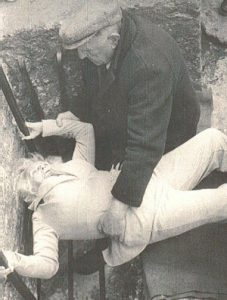genealogists
 Like many avid genealogists, I find myself looking at my roots often. As Saint Patrick’s Day rolls around, I find myself contemplating my Irish roots. I’m sure there are more than I can begin to count, but I specifically know of the Shaw family. These are my grandmother, Harriett Byer’s ancestors. The thing that I find to be sad is that the records are not as extensive as I wish they were. My DNA connects me to this family, but the 1600s is as far as I have been able to trace. I suppose that many people would think that the 1600s is a long way back, but it is barely to the point of their immigration from Ireland to the United States. Even in America, the records aren’t well kept. I find it quite sad that some families are so meticulous in their record keeping, while others just weren’t.
Like many avid genealogists, I find myself looking at my roots often. As Saint Patrick’s Day rolls around, I find myself contemplating my Irish roots. I’m sure there are more than I can begin to count, but I specifically know of the Shaw family. These are my grandmother, Harriett Byer’s ancestors. The thing that I find to be sad is that the records are not as extensive as I wish they were. My DNA connects me to this family, but the 1600s is as far as I have been able to trace. I suppose that many people would think that the 1600s is a long way back, but it is barely to the point of their immigration from Ireland to the United States. Even in America, the records aren’t well kept. I find it quite sad that some families are so meticulous in their record keeping, while others just weren’t.
My Grandma Byer and her siblings were proud of their Irish roots. In their later years, they took a trip to Ireland to search for family information, graves, and living family members. I’m not sure if they found much  information, but without computers, information was harder to find then. It’s not that computers didn’t exist, but rather the simple fact that none of them knew how to use one. Nevertheless, they had a wonderful trip. They explored castles, town and villages, and they saw the amazing green fields that are synonymous of Ireland. They also did something that I have found interesting, when the had the opportunity to kiss the Blarney Stone. For those who don’t know about the Blarney Stone, “The Blarney Stone (Irish: Cloch na Blarnan) is a block of Carboniferous limestone built into the battlements of Blarney Castle, Blarney, about 8 kilometers (5 miles) from Cork, Ireland. According to legend, kissing the stone endows the kisser with the gift of the gab (great eloquence or skill at flattery).” It’s really just a goofy tradition, but I suppose it is a fun idea, and one they decided was worth testing.
information, but without computers, information was harder to find then. It’s not that computers didn’t exist, but rather the simple fact that none of them knew how to use one. Nevertheless, they had a wonderful trip. They explored castles, town and villages, and they saw the amazing green fields that are synonymous of Ireland. They also did something that I have found interesting, when the had the opportunity to kiss the Blarney Stone. For those who don’t know about the Blarney Stone, “The Blarney Stone (Irish: Cloch na Blarnan) is a block of Carboniferous limestone built into the battlements of Blarney Castle, Blarney, about 8 kilometers (5 miles) from Cork, Ireland. According to legend, kissing the stone endows the kisser with the gift of the gab (great eloquence or skill at flattery).” It’s really just a goofy tradition, but I suppose it is a fun idea, and one they decided was worth testing.
The big Saint Patrick’s Day parties are far more an American tradition than it is as Irish one. In fact, people might be surprised at the real background of the day. Saint Patrick’s Day was made an official Christian feast day in the early 17th century and is observed by the Catholic Church, the Anglican Communion (especially the Church of Ireland), the Eastern Orthodox Church, and the Lutheran Church. In reality, It is a day that  commemorates Saint Patrick and the arrival of Christianity in Ireland. It also celebrates the heritage and culture of the Irish in general. Celebrations generally involve public parades and festivals, cèilidhs (a social event at which there is Scottish or Irish folk music and singing, traditional dancing, and storytelling), and the wearing of green attire or shamrocks. Some Catholic Christians also attend church services and historically in Ireland the Lenten restrictions on eating and drinking alcohol were lifted for the day, which is likely where the holiday’s tradition of alcohol consumption came from. So, whether you celebrate in the tradition of America or the tradition of Ireland, Happy Saint Patrick’s Day to one and all.
commemorates Saint Patrick and the arrival of Christianity in Ireland. It also celebrates the heritage and culture of the Irish in general. Celebrations generally involve public parades and festivals, cèilidhs (a social event at which there is Scottish or Irish folk music and singing, traditional dancing, and storytelling), and the wearing of green attire or shamrocks. Some Catholic Christians also attend church services and historically in Ireland the Lenten restrictions on eating and drinking alcohol were lifted for the day, which is likely where the holiday’s tradition of alcohol consumption came from. So, whether you celebrate in the tradition of America or the tradition of Ireland, Happy Saint Patrick’s Day to one and all.

